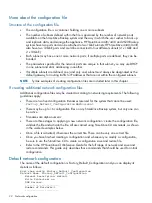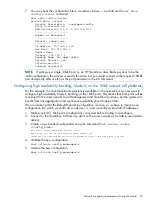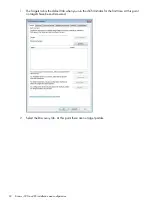
4 Network configuration
In this chapter:
•
•
The network configuration wizard (page 18)
•
More about the configuration file (page 22)
•
Default network configuration (page 22)
•
Identifying network ports (page 23)
•
Network configuration examples not using the wizard (page 24)
Networking overview
The HP StoreOnce Backup system supports IPv4 only. Networking parameters are contained within
a network configuration file.
There are three options when configuring the network for the first time.
•
For ease of installation, a default configuration file is supplied with the StoreOnce Backup
system. As long as LAN port 1 of the appliance is connected to a DHCP–enabled 1GbE
network switch, the HP StoreOnce Backup system will be immediately active on the network
after installation.
The user then has the option of continuing to use the default configuration file or creating and
applying an additional configuration file that is tailored to their exact networking requirements.
This is done via the StoreOnce CLI using an SSH application such as PuTTy.
NOTE:
If DHCP is supported, it is recommended that once an IP address has been assigned,
the system Administrator should permanently associate that IP address with the StoreOnce
Backup system. This will avoid any problems with the IP address of the device changing over
reboots.
To find out the IP address that has been assigned, connect to the CLI using a console (keyboard
and monitor) and use the StoreOnce CLI command:
nl
net show status all
•
There is a single StoreOnce CLI wizard command,
net set wizard
. This command provides
a prompted sequence of steps to enable full configuration of network settings. It creates and
activates a new configuration file. See
The network configuration wizard (page 18)
.
•
It is also possible to create and modify configuration files manually. When a configuration
file is activated, it becomes the
Current
file. See also
When is the default configuration file not adequate?
The default configuration file is adequate if the main use of the Ethernet network will be to access
the StoreOnce Management Console (GUI and Command Line Interface) remotely. However, many
users will require more flexible networking configurations. For example:
•
The use of all available ports to connect to multiple subnets; each subnet could have a different
function, such as iSCSI VTL, NAS, Catalyst, replication, depending upon the estimated volume
of data and performance requirements for the various StoreOnce functions
•
Bonding of available ports to provide link aggregation and failover
The HP StoreOnce 4400 Backup system family has two 10GbE ports as well as two 1GbE
ports. A recommended configuration might be a bonded subnet on the 10GbE network for
Networking overview
17
















































